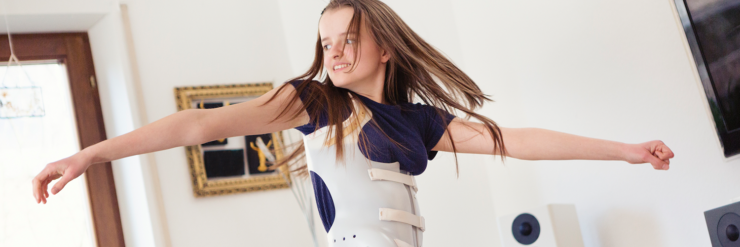Scoliosis is a sideways curve of the spine and back, with curves sometimes following an “S” or a “C” shape. It typically occurs in adolescents between 10 and 18 years old, and is relatively common, affecting as many as 2 to 3 percent of the population.
How to Know If You Have Scoliosis
Many people with scoliosis don’t know they have it because it often doesn’t cause any pain. However, if you notice any of these signs, it’s a good idea to talk to your doctor:
- One shoulder that is higher than the other
- Clothes that don’t fit quite right around the shoulders or hips
- One side of your ribcage protrudes more than the other
- One hip that appears higher than the other
- An uneven waist
- Leaning to one side
Even if there aren’t any signs of scoliosis, a child’s back is screened annually by looking for asymmetry in the shoulders, ribs or hips when standing and bending over. This is done by your school nurse or primary care provider during the pre-adolescent and adolescent years. If asymmetry is noted, your provider will likely send you to a specialist for further evaluation.
Curves are diagnosed on standard spine radiographs. The Spine and Scoliosis Center at Stony Brook Orthopaedic Associates, for example, uses low dose EOS® imaging, which provides full-body 2D and 3D images of the spine.
Is Scoliosis Genetic?
Scoliosis can have a genetic component. While the cause of most scoliosis cases is unknown, research suggests that genetic factors can play a role in its development.
If a family member has scoliosis, you may have a higher risk of developing it yourself. However, not everyone with a family history of scoliosis will develop the condition.
Can Scoliosis Be Fixed?
Scoliosis treatment methods depend on various factors, including the severity of the spine curvature, the patient’s age, and whether the condition is still progressing.
In general, curves below 25 degrees are considered mild curves, and are typically observed to ensure they don’t worsen and possibly prescribed physical therapy. Curves between 25 and 50 degrees are more moderate in nature, and children with growth remaining would be prescribed a brace.
Curves greater than 50 degrees are considered severe and at that magnitude, an orthopaedic surgeon would begin a conversation about surgical options. Keep in mind, these are generalizations and every treatment plan is tailored for each specific patient.
When Should Patients Consider a Scoliosis Brace?
While scoliosis braces are primarily used to prevent curves from becoming more severe, a study at Stony Brook found that 45 percent of children who wore their brace as prescribed, and followed their exercise program daily, experienced a 5-degree improvement.
In adolescents with growth remaining, I typically begin bracing for moderate curves, which are above 25 degrees. In patients younger than 10, I consider bracing if the curvature is becoming more pronounced, or over 20 degrees.
In recent years, scoliosis brace designs have become more manageable for children, and the recommended hours of usage is now shorter. When I trained, the regimen was 24 hours a day of brace wear, but now, 16 hours per day of brace wear is recommended, as there is statistically and clinically no difference between the two methods.
For some types of scoliosis, adolescents may be offered a night-time only brace.
What are the Surgical Options for Scoliosis?
The gold standard in managing scoliosis from a surgical standpoint is a spinal fusion, and the art and skill required of the surgeon is to develop a surgical plan that best addresses the unique nature of the curvature and the expectations of the patient.
New techniques such as growth modulation using spinal tethering are available for children with moderate curves who have significant growth remaining.
Is it Safe to Be Active with Scoliosis?
Historically, children with scoliosis were advised to avoid exercises that would increase the flexibility of the spine, such as gymnastics or tumbling. However, recent evidence shows no link between sports played and curve progression or development. Currently, patients are able to play whatever sport they wish.
Stony Brook Orthopaedic Associates offers a wide variety of operative and non-operative services for treating scoliosis and many other orthopaedic conditions. To make an appointment with an orthopaedic expert, call (631) 444-4233 or click here for more information.












